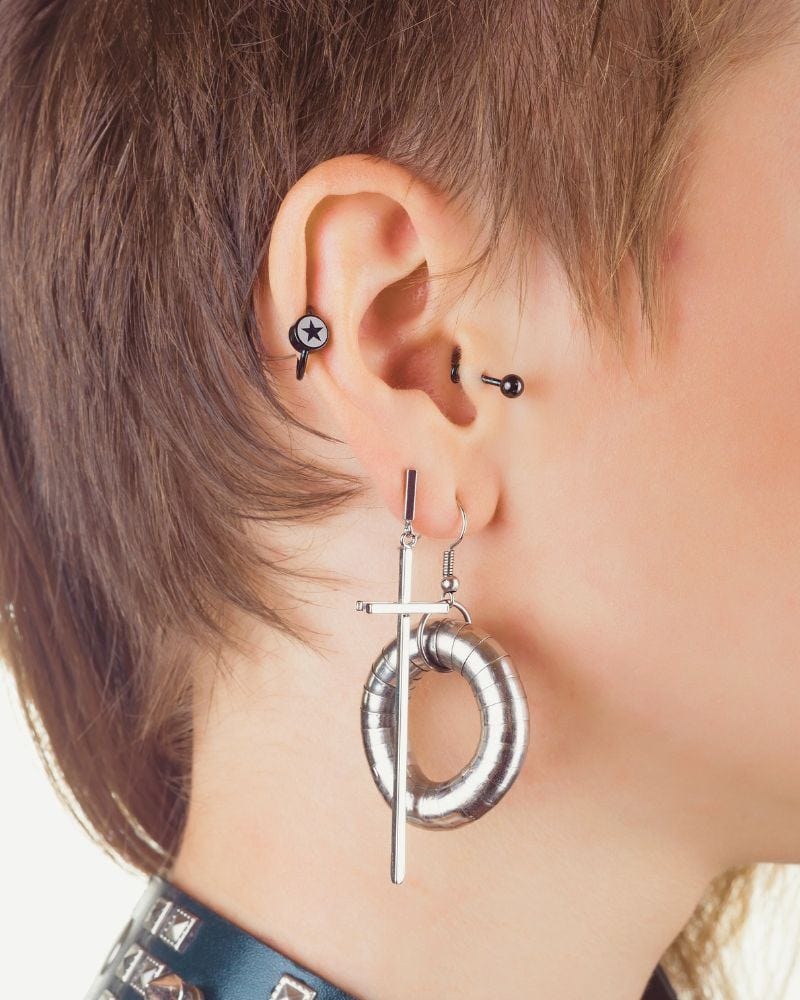New Trends For Ear Piercing Over 50
Wearable art on a curated ear
I miss earrings. My body chemistry changed when my son was born, and now I’m allergic to nickel. I can’t even wear earrings made for “sensitive ears”. So, when I see people sporting awesome piercings, I get a little jealous.
To be honest, even if I COULD wear earrings, I’d stick with tradition. No lip piercings for me, thank you.
BUT, if you’re looking for the latest trends in ear piercing for the over-50 crowd, I’ve got you covered.
Honestly, there’s no “appropriate age” for ear piercings. It’s really just a matter of choosing what you look.
What’s your pain tolerance?
If you started with a “beginner set” of pierced ears as a child (or adult), you probably remember the quick sting and (albeit short-lived) throbbing burn as the studs pierced your earlobes.
If you found that a little too much to bear, you may not be interested in a daith piercing. This one passes through the ear’s innermost cartilage fold, a very sensitive area.
Different Ear Piercings Explained
To help you decide what ear piercings might work best for you, I’ve listed the most common options, including the perceived pain level, healing time, and cost.
Helix Piercings
This trendy spot at the top of the ear is for a tiny stud or hoop.
Pain Level: Moderate – cartilage piercings can be a bit painful.
Healing Time: 6–12 months.
Cost: $30–$80, depending on the studio and jewelry choice.
Examples of helix piercings: SkinKandy.com
Tragus Piercings
Located near your ear canal, tragus piercings are often paired with surgical steel or precious metals to avoid irritation.
Pain Level: Moderate to High – the cartilage is thicker, so expect some discomfort.
Healing Time: 6–12 months.
Cost: $40–$90.
Examples of tragus piercings: Impuria.com
Forward Helix
Just above your earlobe and closer to your face, this delicate spot is gaining popularity, especially for women who want a unique touch.
Pain Level: Moderate – thinner cartilage than other areas, but still tender.
Healing Time: 6–12 months.
Cost: $40–$100.
Examples of helix piercings: Maria Tash
Multiple Lobe Piercings
For this trend, additional holes are added along the earlobe. This allows for creative earring combinations and a personalized look.
Pain Level: Low – the lobe is soft tissue and relatively painless to pierce.
Healing Time: 6–8 weeks.
Cost: $20–$50 per piercing.
Examples of multiple lobe piercings and stacked lobe piercings: Bluebanana.com
Conch Piercing
The conch piercing is located in the inner cartilage of the ear. It can accommodate a stud or a hoop that encircles the ear’s outer edge.
Pain Level: Moderate to High – the cartilage is thick and can be sensitive.
Healing Time: 6–12 months.
Cost: $40–$100.
Examples of conch piercings: atpresent.com
Daith Piercing
This piercing passes through the ear’s innermost cartilage fold.
Pain Level: High – it’s a deep cartilage piercing, so it can be quite painful.
Healing Time: 6–12 months.
Cost: $50–$100.
Examples of daith piercings: freshtrends.com
Rook Piercing
This piercing is situated in the cartilage ridge, between the outer and inner ear.
Pain Level: Moderate to High – the cartilage is thick, but the pain is short-lived.
Healing Time: 6–12 months.
Cost: $40–$90.
Examples of rook piercings: assolari.co
Don’t get in the chair until you’ve scoped the place out!
Not all piercing shops are created equal, so do your homework. Look for places with experienced staff, proper sterilization techniques, and good reviews.
Certification and Licensing
To start, verify that the piercer holds proper certifications and licenses.
A qualified professional should have training in body piercing and bloodborne pathogen safety.
It’s also essential to verify that the studio complies with local health regulations and holds a valid license to operate.
Cleanliness and Sterilization
A professional piercing studio should be visibly clean and organized, with separate areas for sterilization and piercing.
They should use an autoclave to sterilize their equipment and show you a sealed, sterile needle before starting. These are signs of a clean and safe environment.
Quality Jewelry
The jewelry offered is a key indicator of professionalism.
A skilled piercer will provide hypoallergenic options like titanium, surgical stainless steel, 14k or higher gold, or niobium.
The jewelry should be appropriately sized and designed to support healing and minimize irritation.
Tools and Techniques
A qualified technician will use a hollow, single-use needle rather than a piercing gun.
Needles are more hygienic, precise, and less likely to damage tissue. This is a crucial distinction to look for when choosing a piercer.
Consultation and Communication
A professional piercer will take time to consult with you before the procedure.
They’ll discuss placement, explain potential risks, and provide detailed aftercare instructions.
If you have questions, they should answer them clearly and confidently, ensuring you feel comfortable moving forward.
Safety Practices
During the procedure, observe their safety practices. The piercer should wear disposable gloves and change them frequently.
All tools should come from sealed, sterilized packaging to ensure maximum hygiene and safety.
Reputation and Reviews
Research the studio’s reputation before making your choice.
Check online reviews on platforms like Google or Yelp to see what other customers have said. Recommendations from friends or family who’ve had good experiences can also be incredibly helpful.
Professional Affiliations
Membership in professional organizations like the Association of Professional Piercers (APP) is another strong indicator of a skilled and safety-conscious piercer.
Did you find this post useful? If so, please consider supporting my writing with a paid subscription.
Let’s talk!
What piercings do you have? Leave a comment below!





